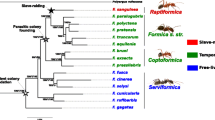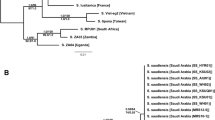Summary.
Slave-making (dulotic) ants have long fascinated biologists because of their intriguing behavior and highly specialized lifestyle. Dulosis evolved convergently several times within the two ant subfamilies Myrmicinae and Formicinae. Here, we demonstrate that it originated at least six times independently within the small myrmicine tribe Formicoxenini alone. Our phylogenetic trees, based on 1386 base pairs of the mitochondrial cytochrome oxidase gene, document different degrees of genetic divergence between different monophyla of slave-makers and their host species, which suggests that they evolved from non-parasitic Formicoxenini at different times. Two nearctic slave-makers, Temnothorax duloticus and a new species still to be formally described, appear to be of particularly recent origin. In contrast, the other parasitic monophyla clearly diverged much earlier from their nonparasitic ancestors and have a much longer evolutionary history.
Similar content being viewed by others
Author information
Authors and Affiliations
Corresponding author
Additional information
Received 4 January 2005; revised 21 February 2005; accepted 1 March 2005.
Rights and permissions
About this article
Cite this article
Beibl, J., Stuart, R.J., Heinze, J. et al. Six origins of slavery in formicoxenine ants. Insectes Soc. 52, 291–297 (2005). https://doi.org/10.1007/s00040-005-0808-y
Issue Date:
DOI: https://doi.org/10.1007/s00040-005-0808-y




